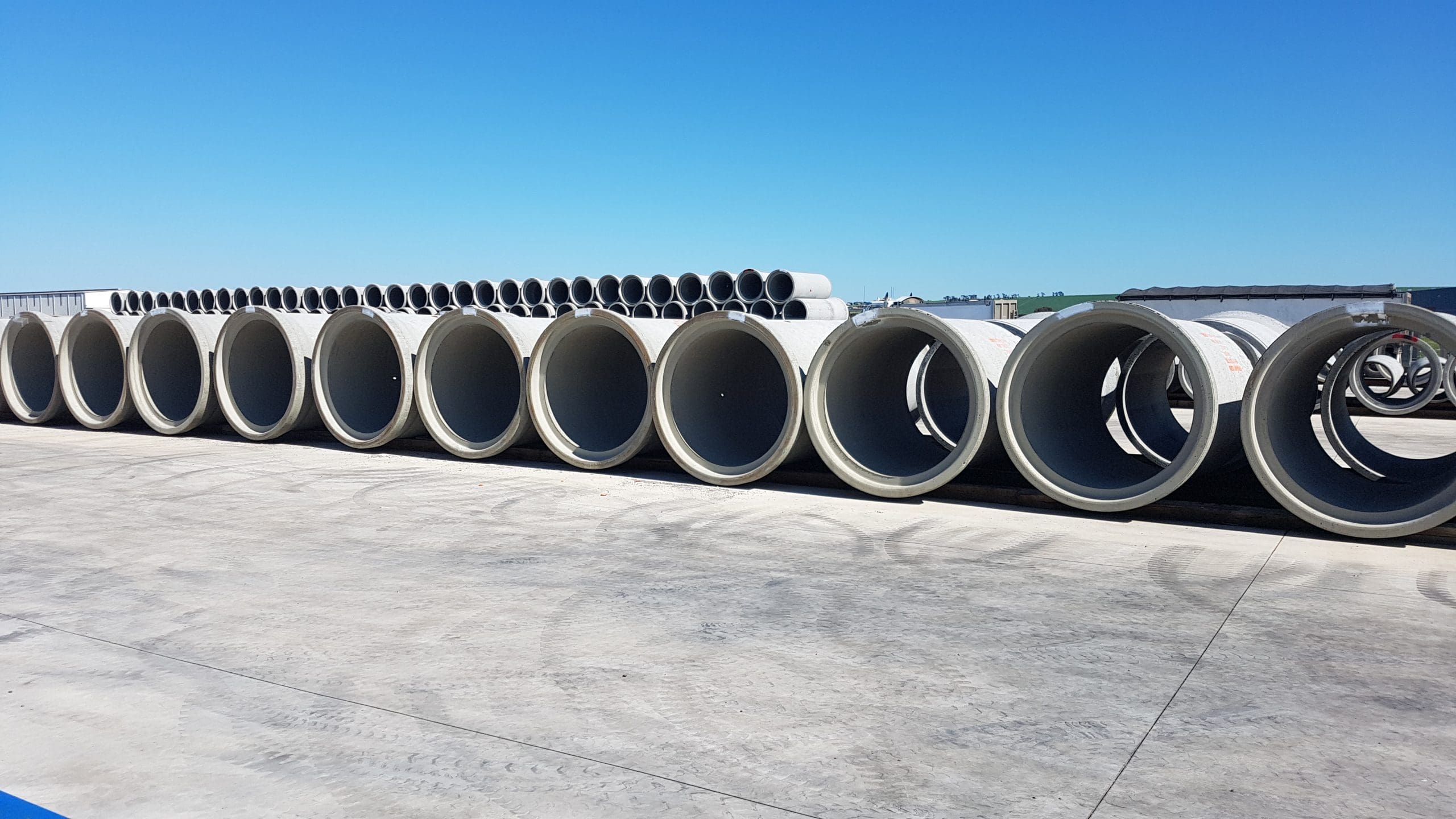An Ultimate Guide to Culvert Pipes
There are many good reasons to install a culvert pipe. It will, for example, ensure the long-term structural integrity and safety of your property by reducing the risk of flooding, waterlogging, erosion…! Our ultimate guide to culvert pipes explains what culvert pipes are, their function, uses, advantages, and disadvantages. We’ll also explain the differences between a box culvert vs pipe culvert. As always, our aim as a leading industry authority is to equip you with the information you need to make informed choices about all your drainage requirements.
What Are Culvert Pipes?
Culvert pipes are heavy-duty reinforced pipes designed for use in water / fluid management systems. They come in a range of materials and sizes to suit different applications and environments. Civilmart’s reinforced concrete pipes for example can be used in many industrial and agricultural applications, and are available with either flush or rubber ring joints. We also have spigot-spigot culvert pipes for use with our purpose-built headwalls.
Why Are Culvert Pipes Important?
Installing a box culvert or culvert pipe is central to any effective drainage and water management system. Importantly, these structures help control flooding, and prevent waterlogging, soil erosion, and structural damage by diverting water away from valuable infrastructure like roads, railways, and buildings. At the same time, it ensures the safety of those who use the infrastructure.
In industrial and commercial settings, culvert pipes can be used to transport and manage large volumes of wastewater. This prevents it contaminating the surrounding environment, and getting into natural waterways, and groundwater.
Reinforced culvert pipes are also important as stream crossings and bridge foundations when installed under footpaths, roads, and railways. This helps maintain safe natural drainage systems and avoids disrupting the ecosystems that rely on this water.
Uses of Culvert Pipes
Main use cases for culvert pipes include:
- Stormwater management and drainage: box culvert and culvert pipe installations in drainage and stormwater management systems protect infrastructure from flooding and erosion.
- Industrial wastewater management: industrial wastewater control and management systems use culvert pipes to transport wastewater, control water flow, and prevent contaminated water getting into the environment.
- Protecting natural water flow and the environment: where natural groundwater systems such as streams and rivers intersect infrastructure, installing culvert pipes maintains the natural water flow. This is particularly important in environmentally sensitive areas where there is a requirement to prevent damage and disruption to natural structures and ecosystems.
- Road and railway drainage: concrete culvert pipes and concrete box culverts are commonly used to drain and control water flow in and around roads, highways, railway lines, footpaths, and other similar infrastructure to protect the beds from erosion.
- Bridge foundations: box culverts and pipes often form part of the foundation for bridges where they not only control water drainage but also provide structural strength.
- Agriculture and land drainage: in agricultural and industrial farming settings, you’ll often see culvert pipes used to manage water flow for irrigation and land drainage.
- Culvert liners: culvert pipes can be used to line or repair existing culverts and drainage channels, improving their effectiveness and/or prolonging their service life.
- Utility infrastructure: culvert pipes are used as conduits for protecting and maintaining underground utility infrastructure like electrical and communication cables, sewage, and gas.
Culvert Pipe Materials in Construction
Civilmart specialises in concrete culvert pipes and box culverts that are strong, durable, and suit most applications. However, depending on your budget, and installation requirements, culvert pipes are also manufactured from plastic, steel, and corrugated iron. Each has its own unique properties, advantages, and disadvantages.
Concrete
At Civilmart, we’re a bit biased in favour of concrete for all the reasons mentioned above! We manufacture a reinforced concrete culvert pipe that is are super strong, comes in a range of diameters, and is manufactured to last, even in the most severe environments. The pipes come with flush joints, or rubber ring joints for sealed, watertight joins, or with spigot ends that fit our concrete headwalls.
A concrete culvert pipe, like a concrete box culvert, is well suited for most situations, including high-traffic areas, and areas that need to withstand heavy loads. They are durable, strong, reliable, corrosion-resistant, hardwearing, and will easily last 50+ years. However, they are heavy, and can be expensive and difficult to install without the right equipment and technical expertise.
Plastic
Some smaller types of installations in non-weight bearing areas such as residential drainage, or where the water needs to be potable (irrigation and agricultural applications), may suit a plastic culvert pipe or plastic box culvert.
Modern plastic culvert pipes and box culverts are made from either corrugated or double sided PVC (polyvinyl chloride) or HDPE (high-density polyethylene). They are lightweight, corrosion-resistant, cost-effective, and relatively easy to transport and install. However, they are not designed for heavy duty, or heavy traffic, applications.
Structural Steel Plate
SSP (Structural Steel Plate) culvert pipes, also known as ‘multi-plate pipes’, can be used in heavy load bearing or high water pressure applications. They are made from corrugated galvanised steel plates and are typically transported to site in sheet form to be bolted together in situ. Unlike other types of culvert pipes, SSP pipes are not necessarily round but can be oval, flat-bottomed, open bottomed arches, or various other customised configurations.
Steel culvert pipes are easy to transport and customise. They can also withstand harsh environments/extreme conditions, have a relatively long life span courtesy of the galvanised surface, and suit large diameter installations where it may be impractical to use a concrete culvert pipe. However, assembling them can be time consuming and they will corrode if subjected to galvanisation.
Corrugated Steel
As opposed to SSP pipes, CSP (Corrugated Steel Pipe) or CMP (Corrugated Metal Pipe) pipes are made from a single piece of galvanized steel and are supplied ready to install. They offer many of the same features as SSP culverts – strength, durability, longevity, versatility, and large diameter installations… They are also relatively lightweight and somewhat flexible so suit uneven ground and areas that experience ground movement. However, as with any metal that is constantly exposed to water, there is potential for galvanisation and thus corrosion.
Advantages of Culvert Pipes
The advantages of using culvert pipes over other types of drainage systems include:
- Ideal for small to medium-sized installations
- Efficient drainage and water management – both stormwater and wastewater
- Strength, durability, and longevity
- Control flooding and erosion
- Protect and maintain the integrity and safety of infrastructure
- Environmentally friendly and help protect the environment and fragile ecosystems
- Concrete culvert pipes in particular are low maintenance
- Cost-effective solution for most drainage needs
- Easy to install compared to some other types of drainage systems
- Offer good hydraulic performance
- Can be customised to suit most environments and installations
Disadvantages of Culvert Pipes
Despite their many advantages, culvert pipes also have their disadvantages. Notably:
- They have a smaller capacity and aren’t as strong as box culverts so are not as well suited for large projects.
- Installation can be labour-intensive and require specialised equipment. Concrete culvert pipes for example are heavy whilst SSP culvert pipes require on site erection.
- All types of culvert pipes can clog up or experience sediment build up if not properly maintained, particularly in areas prone to flooding, or where there is a lot of rubbish in the water.
- Culvert pipes can be damaged if subjected to conditions outside their specified rating i.e. heavy loads, extreme weather conditions.
- Not all culvert pipes suit all types of installations. Plastic culvert pipes for example are not suited for heavy-duty applications and may not suit high temperature environments either. Concrete pipes may crack in areas where there is a lot of ground movement. Steel culvert pipes can corrode in environments where galvanisation occurs.
- There is always potential for installation errors that can lead to leaks, misalignment, and insufficient capacity.
- They may experience buoyancy issues in areas with a high water table, particularly if installed when the water table is low, and if higher water levels are not factored into the installation.
- There is always a risk of structural failure due to faulty manufacturing or unexpectedly adverse conditions.
- Even the biggest culvert pipes have a limited flow capacity.
- They may pose an environmental risk to natural ecosystems and waterways with respect to natural water flow and contamination if incorrectly or inadequately installed.
What’s the difference between a Box Culvert and a Culvert Pipe
Box culvert vs pipe culvert – what are the differences between the two?
Why Choose Civilmart for Your Concrete Culvert Pipe?
At Civilmart, our unparalleled experience, expertise, reputation, and superior products have made us a trusted industry leader in drainage solutions. Manufactured using only superior materials, our products are of the highest quality and meet the most stringent industry standards. Partner with us and experience:
- Unparalleled product quality and performance
- Expert advice and guidance
- Competitive pricing and prompt delivery
Visit our website or contact us about your culvert pipe requirements and discover the Civilmart difference.
Join the Civilmart family
Stay up to date with latest product releases, newest industry innovations and more!



